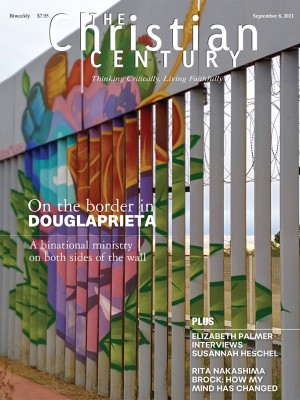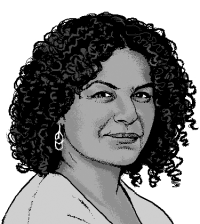Jesus the poet
We are invited to bring the rich resources of our senses and imaginations into the realm of faith.

I know the Jesus who commands us to love our neighbors, feed the hungry, take up our crosses, and lay down our lives. But there’s another Jesus I don’t know as well. He’s a Jesus I often find baffling in my frenzied, overscheduled life.
He’s the Jesus who stands on a hilltop and invites us to “consider the lilies” and “behold the birds.” The Jesus who offers his followers a balm for anxiety in the profusion of wildflowers and the antics of sparrows. He is Jesus the poet, the artist, the naturalist, the contemplative. The man who, according to Luke’s Gospel, “often slipped away to the wilderness to pray.” The man who woke up before sunrise to climb mountains; who cherished seashores, gardens, deserts, and “secluded places”; who paid exquisite attention to beauty.
How well do we know him?
I grew up in a religious community that didn’t put much stock in “considering” and “beholding” loveliness. Which is to say, we didn’t put much stock in sensory experience; we actively distrusted it. Ours was not a religion of nature, beauty, creativity, art, or the imagination. It was a religion of unadorned belief. Bare walls, bare worship.
Read our latest issue or browse back issues.
The point of our austerity was to keep us focused on what really mattered: our creeds and confessions. Those alone would keep us holy in a sinful, fallen world.
But even as a child, I didn’t understand why so much of what I loved about the world—the complexity of nature, the artistry of the written word, the gifts of the human imagination—had no place in church, no connection to the sacred. Why was it that from Monday through Saturday, I could revel in a star-studded sky, a lake at dawn, a finely crafted sentence, or the softness of freshly baked bread, but I could never experience such wonder in connection to God? Why were my senses suspect, my imagination idolatrous? Why did God create a universe bursting with color and sound, light and shadow, taste and texture, if I wasn’t supposed to relish God’s cosmic cathedral in worship?
Nowadays, the barrier to my relishing is no longer theological; it’s practical and mundane. I’m too busy running around to even see the lilies and the birds, much less honor them with my presence and awareness. Too often, God’s cathedral is the mere backdrop I race past. In the craziness of contemporary life, I forget that Jesus commands us to foreground what we often ignore—to bring the rich resources of our senses and imagination into the realm of faith, because all of God’s good earth is sanctuary, and the lilies and birds have something to teach us about peace. This is a resounding call to pay attention, which is as good a definition of prayer as I hope to find.
The call is everywhere in scripture. It’s in Genesis, where God commissions Adam and Eve to become co-artists and co-makers, drawing out the loveliness in God’s “very good” creation. It’s in the story of the liberated Israelites, who pour their talents into building God’s house according to a divine design. It’s in the poetry of the psalmists and the prophets, who instruct us to worship God in the beauty of holiness—in a thundering waterfall, a still pool of water, the movement of the planets, the deep silence after a storm. It’s in the very being of Jesus, who soaks in the waters of baptism, basks in perfumed oil running between his toes, tastes tears at Lazarus’s grave, and offers his physical scars to his disbelieving disciples: “Touch me and see.”
Jesus asks us to consider the lilies and behold the birds because every experience we have of the holy is grounded in the physical world we live in, the bodies we inhabit. God calls us to live an integrated life, a life in which our words and our worlds, our beliefs and our bodies, our creed and God’s creation infuse, enrich, mirror, and reinforce each other.
This integration isn’t Christianity’s side dish; it’s the main course. It’s why we’re here: to notice, to reflect, to repair, and to multiply beauty. To be co-makers, because “when we make,” says artist Makoto Fujimura, “we invite the abundance of God’s world into the reality of scarcity all around us.”
But we can’t do this if we keep our faith lives tethered to abstractions, if we live a Christianity of the mind. Our faith is meant to be glimpsed, grasped, tasted, smelled, swallowed, and savored.
So I’m learning these days to cultivate a belief akin to Wendell Berry’s, who tells us that “there are no unsacred places; there are only sacred places and desecrated places.” A belief that honors St. Benedict’s conviction that God is alive in the details, present in the concrete realities of everyday life, such that every tool, every utensil we take up can be considered sacred. A belief that affirms Barbara Brown Taylor’s sense that our world is “so thick with divine possibility that it is a wonder we can walk anywhere without cracking our shins on altars.”
In the end, the Jesus who asks us to “consider” and “behold” is the same Jesus who asks us to seek justice, healing, wholeness, and liberty for this pain-filled world. Why? Because it’s only when we know how to apprehend and honor the beautiful that we’ll respond appropriately when the beautiful is mistreated, diminished, denied, or destroyed. We won’t protect what we don’t love or respect what we don’t notice. So consider the lilies. Behold the birds. They are the poems of God.







